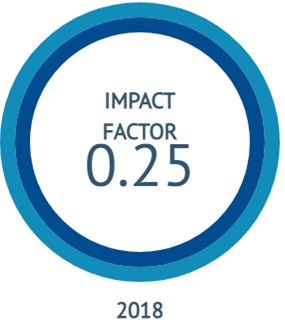Molecular Docking and Toxicity Test of Apigenin Derivative Compounds as an Anti-Aging Agent
Abstract
The intrinsic factors that caused aging are enzymes such as hyaluronidase and elastase by oxidative stress mechanism. Antioxidants are the bioactive compounds which are highly important to fight against oxidative stress that can cause aging. Modified compounds o121–15f apigenin have reported can act as an antioxidant. The aim of this study was to determine candidate of apigenin derivative compounds that were potential to inhibit hyaluronidase and elastase enzyme by using molecular docking method with human target protein with pdb.id : 2JIE and 5JMY. Molecular docking was done using windows operating system with several softwares, i.e: PLANTS, YASARA and MarVinSketch. Visualization of bonding modes between the ligand and amino acid residues was done with PyMol. Of the 50 apigenin derivative compounds tested, obtained 9 compounds with lower docking scores than apigenin in inhibiting hyaluronidase and 5 compounds in inhibiting elastase enzyme. 3’6-diamineapigenin had the lowest docking score (-62.39) in inhibiting hyaluronidase enzyme (2JIE) and 3’amineapigenin had the lowest docking score (-91.31) in inhibiting elastase enzyme (5JMY). The binding interactions of the actively docked conformations of the ligand and the target protein have been identified and showed the most amino acid residues that considered affect hyaluronidase and elastase inhibition process such as VAL_710, GLU_762 and VAL_763. Based on these results, there are some antioxidants of the apigenin derivative compounds that recommended as an anti-aging agent.
Keywords: apigenin, antioxidant, anti-aging, molecular docking
Downloads
References
2. Uttara B, Singh A, Zamboni P, Mahajan R. Oxidative Stress and Neurodegenerative Diseases: A Review of Upstream and Downstream Antioxidant Therapeutic Options. C. 2009;7(1):65-74. doi:10.2174/157015909787602823
3. Baker JR, Woolfson DN, Muskett FW, Stoneman RG, Urbaniak MD, Caddick S. Protein–Small Molecule Interactions in Neocarzinostatin, the Prototypical Enediyne Chromoprotein Antibiotic. C. 2007;8(7):704-717. doi:10.1002/cbic.200600534
4. Korb O, Stützle T, Exner TE. Empirical Scoring Functions for Advanced Protein−Ligand Docking with PLANTS. J. 2009;49(1):84-96. doi:10.1021/ci800298z
5. Kastritis PL, Bonvin AMJJ. On the binding affinity of macromolecular interactions: daring to ask why proteins interact. J. 2012;10(79):20120835-20120835. doi:10.1098/rsif.2012.0835
6. Khalid A. Design and Molecular Docking of Antioxidant Lead Compound and its Analogues Acting as Human Tyrosine Kinase Inhibitors. I. 2013;5(4):75-80. doi:10.9790/3008-00547580
7. Kumar KM, Anitha P, Sivasakthi V, et al. In silico study on Penicillin derivatives and Cephalosporins for upper respiratory tract bacterial pathogens. 3. 2013;4(3):241-251. doi:10.1007/s13205-013-0147-z
8. Longo VD. Evolutionary Medicine: From Dwarf Model Systems to Healthy Centenarians? Science. 2003;299(5611):1342-1346. doi:10.1126/science.1077991
9. Makrantonaki E, Brink TC, Zampeli V, et al. Identification of Biomarkers of Human Skin Ageing in Both Genders. Wnt Signalling – A Label of Skin Ageing? Ouzounis CA, ed. P. 2012;7(11):e50393. doi:10.1371/journal.pone.0050393
10. Mumpuni E, Mulatsari E. QSAR Analysis on Apigenin Derivative Compounds as Antioxidant Using Semiempirical Austin Model 1. A. 2017;29(7):1499-1505. doi:10.14233/ajchem.2017.20535
11. Ndlovu G, Fouche G, Tselanyane M, Cordier W, Steenkamp V. In vitro determination of the anti-aging potential of four southern African medicinal plants. B. 2013;13(1). doi:10.1186/1472-6882-13-304
12. Pogrel MA, Lowe M-A, Stern R. Hyaluronan (hyaluronic acid) in human saliva. A. 1996;41(7):667-671. doi:10.1016/s0003-9969(96)00050-7
13. Seo M-H, Park J, Kim E, Hohng S, Kim H-S. Protein conformational dynamics dictate the binding affinity for a ligand. N. 2014;5. doi:10.1038/ncomms4724
14. Seyoum A, Asres K, El-Fiky FK. Structure–radical scavenging activity relationships of flavonoids. P. 2006;67(18):2058-2070. doi:10.1016/j.phytochem.2006.07.002
15. Tassa C, Duffner JL, Lewis TA, et al. Binding Affinity and Kinetic Analysis of Targeted Small Molecule-Modified Nanoparticles. B. 2010;21(1):14-19. doi:10.1021/bc900438a
Copyright (c) 2018 Journal of Applied Chemical Sciences

This work is licensed under a Creative Commons Attribution-NonCommercial-ShareAlike 4.0 International License.

 Esti Mumpuni(1*)
Esti Mumpuni(1*)










